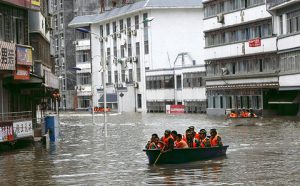With China engaged in a strong push for “sponge cities” – cities that can absorb stormwater without directing it all into drainage systems – the idea of levying fees or charges to manage stormwater has also been raised here. Housing minister Chen Zhenggao said at a national training session on sponge cities that China would look at overseas experiences and study systems for charging for stormwater disposal. There are plenty of examples as stormwater fees are already in place in a number of regions in the US, Germany and other countries.
Stormwater is polluted water
The idea of charging for disposal of rain may seem odd. As some internet users have asked, if we’re charged for rain then what next? Will we have to pay to breathe the air or enjoy sunshine?
“Breathing air or sunbathing doesn’t harm the environment,” said Yu Nian, head of Guangzhou University’s Sponge City Construction Institute. “But impermeable structures such as roofs, roads and city squares accumulate pollution, which is washed off by stormwater. If it’s not treated then it causes serious pollution of rivers and lakes. So a stormwater fee is similar to fees for wastewater disposal: it used to be free, but now it’s charged for.”
And downpours don’t just flood our cities. What looks like pure rainwater becomes polluted when it reaches the ground (there’s a good explanation here). The technical term is “stormwater runoff pollution”, which carries large quantities of organics, pathogens, heavy metals, hydrocarbons and suspended matter picked up from the air, roads and buildings. This pours into rivers and lakes, causing pollution.
“Stormwater pollution is one of the main causes of rivers turning foul,” said Zhao Minhua, deputy chief engineer at the Shanghai Water Design and Planning Institute. “That’s why it smells bad if you walk by a river on a rainy day.”
The problem is that in many cities, wastewater and stormwater aren’t separated. Stormwater and the surface pollutants it collects flow into the sewers, which cannot cope with the extra volume and overflow into other water bodies causing serious pollution.
This means that better stormwater management is essential. Many areas of the US, Germany, Denmark, Sweden, Australia and France collect some form of a fee or tax on stormwater. But the practice is most widespread in the US and Germany.
As of 2003, 60% of Germany’s population was subject to a stormwater fee, a figure that has grown steadily. Around 20 cities in Denmark, and 1,417 counties, cities and towns across 39 states in the US, also collect fees.
But even in developed nations, the idea of stormwater pollution is recent.
The US passed the Clean Water Act in 1972 to control point sources of pollution. But after more than a decade of cleaning up bodies of water it was recognised that more than 60% of water pollution was coming from stormwater. And so in 1987 the act was amended to include stormwater as a source of pollution, with a licensing system for discharges following in 1990. “Including stormwater discharge as a source of pollution provided a legal basis for collecting a stormwater fee,” said Yu Nian.
Initially, EU countries were most concerned with the risks of flooding from stormwater. Then the 2000 EU Water Framework Directive raised water quality standards and listed pollutants commonly found in stormwater. EU member states gradually banned stormwater from the sewerage systems and built separate stormwater infrastructure, giving rise to stormwater fees.
Encouragement by taxation
Different locations have different levels of rainfall – so how should stormwater be levied?
In some cases, fees are charged in line with water consumption. In Denmark, the stormwater fee is 40% of your wastewater disposal charge, which itself is set according to how much water you use. The Italian city of Ravenna imposes a surcharge of 3% on residents’ water bills.
In other cases, stormwater fees are determined by area of impermeable surface, meaning the building area and any surface areas that have been hardened.
Yuming Jim Su is a water resources engineer who has spent 18 years working on these issues in the US. He recalls that in some places stormwater fees were initially imposed as a percentage of water consumption or disposal costs, or property taxes. But this was unfair because some users were polluting more than they paid for and others were paying for more than they polluted. After research and experimentation, it is now more common to charge by impermeable surface area that includes garden paths, driveways and roofs.
Overall, the annual payments are not expensive.
Washington DC charges between US$1.60 and US$36 a month for detached homes. Most residents of both apartments and houses pay only between US$1.60 and US$2.67 a month.
Germany looks at local rainfall and impermeable surface area of a property to calculate the stormwater fee – between 0.63 euros (US$0.75) and 2.00 euros (US$2.4) per square metre annually.
Many experts agree that it isn’t just about the cost, the charges also increase awareness of stormwater management issues. “Preferential policies and rewards are complementary to stormwater fees,” said Wang Yue, conservation planning expert for Nature Conservancy China. “The ultimate aim isn’t to make money, but to use a range of methods to get everyone to build and use stormwater collection and reuse infrastructure.”
“If there’s a charge, there’s also an incentive,” said Li Junqi, head of the School of Environment and Energy Engineering at Beijing University of Civil Engineering and Architecture.
Property owners can use rooftop gardens and grass over parking spaces and driveways to reduce impermeable area. If the stormwater is absorbed into the soil rather than discharged into stormwater infrastructure, there is no cost to the property owner.
And in many places policies have been put in place to encourage owners to collect or handle their own stormwater, alongside the charges. If Swedish property owners use water butts or rooftop gardens to control stormwater runoff they pay a reduced rate. In Denmark, there are rebates of up to 40%.
In Germany property owners pay less if they install green roofs or stormwater seepage and storage equipment. There can also be rewards for good stormwater management. In Chicago a building with 50% green roof coverage, or a green roof of more than 2000 square feet (185.8 square metres), earns a government bonus for the developer that is paid from the income from stormwater fees.
The money collected isn’t just used for encouraging better stormwater management, it also goes towards maintaining stormwater infrastructure and management.
In Deerfield, Massachusetts, the money is used to maintain drains, outlets and stormwater separation. In Dallas, Texas, the money also goes towards a Storm Water Drainage Fund.
“In the past, everyone thought that water just fell from the sky and had nothing to do with them,” said Yu Nian, who thinks stormwater fees are in line with the “polluter pays” principle. “But roads and roofs stop water from reaching the soil and in environmental terms that damages the circulation of water in the ecosystem – and so there should be a charge.”
Stormwater fees in China
China has seen an increase in stormwater reuse and sponge city construction in recent years. Some cities, including Beijing, Nanjing and Kunming, have implemented policies that require consideration of stormwater management during the design, construction and operation of projects, alongside associated subsidies and fines, in order to encourage projects to better manage stormwater.
But experts interviewed by The Southern Weekly said that no Chinese cities are collecting stormwater fees yet. However, Shanghai and Shenzhen, two cities taking a lead on the issue, are engaged in exploratory research.
“Who collects it, how much, how is it collected, is it right for China? All these [issues] need to be looked at fully,” said Wang Yue.
About every four years since 2005, Li Junqi’s research team have surveyed public attitudes to stormwater infrastructure and policies in Beijing. Most recently, they found that 80% of people say a stormwater fee is reasonable. “Initially people said they’ve never heard of the idea, but as they consider the environmental aspects they come to feel it should be done,” said Li. “The level of acceptance is rising every year, and it will happen eventually.”
Internationally, there has been opposition to stormwater fees when first imposed. According to a Xinhua report, residents of Ravenna in Italy complained of “yet another hidden tax”. Residents in Augusta in the US complained of being “sick of being taxed for every little thing,” and wanted to know “who would oversee this, to prevent waste or cheating.”
“Does the money collected do me any good, how much is it, is it fair, has there been adequate advance publicity, how environmentally aware are the public? All these factors can cause opposition, especially with a new tax such as this,” said Yuming Jim Su.
According to Su, the public are keener on stormwater infrastructure in developed areas and big cities where the environmental impact of stormwater is greater. These also tend to have more educated residents who are more willing to accept the need for a stormwater fee.
Land ownership in China also presents a problem. “In China, most people live in apartments, overseas they live in houses,” said Man Li, deputy head of the Public Private Partnerships Research Institute at the Central University of Finance and Economics. “In China land is public, in the US it is private.”
A number of experts indicated that stormwater management is an emerging field in China, and the collection of a fee may be considered in future.
“Infrastructure in developed nation cities is already complete, they’re not far behind like us,” said Cheng Xiaotao, flood prevention expert at the China Institute of Water Resources and Hydropower Research. “We need to build waste disposal facilities and water treatment plants. It’s a huge burden.”
“In a sense, [the stormwater fee] is an incentive mechanism rather than just a revenue-gathering system,” said Li Dihua. “If you stop your stormwater discharges, you don’t need to pay. There’s an incentive there, encouraging the best possible management of stormwater.”
Originally published in The Southern Weekly. Edited and republished with permission.






![A woman pumps up water from a tubewell in West Bengal despite the red cross that signifies that there is an unacceptable level of arsenic in the water [image by Dilip Banerjee]](https://dialogue.earth/content/uploads/2017/09/Woman-at-tubewell-West-Bengal-Image-by-Dilip-Banerjee-1-300x206.jpg)
